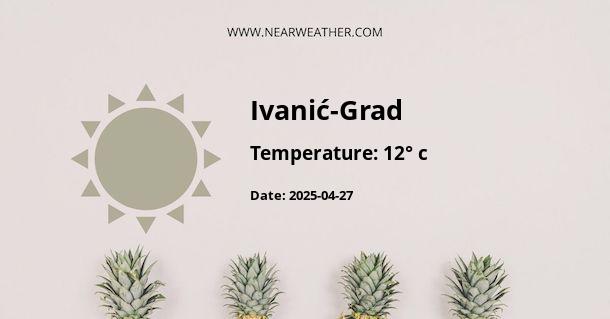Understanding the Climate and Weather of Ivanić-Grad, Croatia
Ivanić-Grad is a small town located in central Croatia, near the country's capital, Zagreb. Known for its picturesque landscapes and cultural heritage, the town also presents an interesting climate that is influenced by its inland position and proximity to the Dinaric Alps. To understand the weather patterns year-round in Ivanić-Grad, it is beneficial to delve into the climate, which is characterized by its continental influences.
The Continental Climate of Ivanić-Grad
The climate in Ivanić-Grad can be classified as a humid continental climate, which is typical for the interior of Croatia. Such climates are known for having four distinct seasons, with warm to hot summers and cold winters.
Temperature Overview
- Summer: During the summer months, from June to August, temperatures can rise above 30°C (86°F), particularly in July, which is the warmest month.
- Winter: Conversely, in the winter, from December to February, temperatures can plunge below 0°C (32°F), with January often being the coldest month.
- Spring and Autumn: The transitional seasons, spring (March to May) and autumn (September to November), feature mild and pleasant weather but can also be unpredictable with rapid changes in temperature and weather conditions.
Precipitation Patterns
Rainfall is relatively evenly distributed throughout the year; however, late spring and early summer tend to be slightly wetter periods. Snowfall is common in winter, and due to Ivanić-Grad’s inland location, snow can be quite plentiful, especially in the nearby mountainous areas.
According to the Croatian Meteorological and Hydrological Service, Ivanić-Grad receives an average annual precipitation of approximately 800 mm, attesting to the fairly humid conditions throughout the year.
Monthly Weather Averages for Ivanić-Grad
To provide a clearer picture of the weather in Ivanić-Grad, let's examine the monthly averages for temperature and precipitation:
| Month | Average High (°C) | Average Low (°C) | Precipitation (mm) |
|---|---|---|---|
| January | 3 | -3 | 42 |
| February | 6 | -1 | 39 |
| March | 11 | 2 | 48 |
| April | 16 | 6 | 55 |
| May | 21 | 11 | 68 |
| June | 24 | 14 | 77 |
| July | 26 | 15 | 73 |
| August | 26 | 15 | 72 |
| September | 22 | 12 | 70 |
| October | 16 | 7 | 69 |
| November | 9 | 3 | 72 |
| December | 4 | -1 | 51 |
This table offers a rough estimation of the weather in Ivanić-Grad, however, given the shifting nature of climate patterns, it is advisable to consult up-to-date meteorological data for travel planning and other purposes.
Extreme Weather Events and Microclimates
While Ivanić-Grad’s weather is typically mild compared to more extreme continental climates, it is not without its occasional severe weather events. Strong windstorms, particularly the bora winds which are cold and dry northeasterly winds, can affect the area, primarily in the winter months. Additionally, summer thunderstorms can be quite intense, sometimes leading to flash flooding.
The varied topography of the region can also lead to microclimates, with localized variations in weather patterns. These microclimates are especially relevant in the nearby hilly and mountainous areas, where cooler temperatures and higher precipitation rates are common.
Sunshine and Daylight Hours
As with many continental climates, the amount of daylight varies significantly throughout the year. During the peak of summer, Ivanić-Grad enjoys up to 15 hours of daylight, which facilitates a variety of outdoor activities. Conversely, in the depths of winter, daylight can be limited to less than 9 hours per day.
- In June, the longest days of the year occur, promoting an extended period of sunshine that often adds to the high temperatures.
- December has the shortest days, which contributes to the chill of the winter season.
Climate Change Considerations
As with many areas around the globe, climate change is influencing the weather patterns in Ivanić-Grad. Recent data suggests shifts in seasonal temperatures, changes in precipitation patterns, and an increased frequency of extreme weather events. These changes may affect the traditional climate characterization of Ivanić-Grad in the years to come.
Climate Change Impacts:
- Rising average temperatures, including more frequent and intense heatwaves during the summer months.
- Alterations in precipitation distribution, which could result in drier summers and wetter winters.
- More frequent extreme weather events, such as heavy rainfall leading to flooding or severe drought conditions.
It is crucial for residents and policymakers in Ivanić-Grad to consider these emerging trends in climate change when planning for future infrastructure, agriculture, and disaster preparedness.
Conclusion
The climate and weather in Ivanić-Grad, Croatia, offer a varied and seasonally distinct experience that reflects the town’s continental placings with subtle Mediterranean influences. From warm summers to cold, snowy winters, it is a region that showcases the four seasons in full swing. While generally moderate, occasional extreme weather and the looming influences of climate change are factors that add complexity to this climate profile. For those planning to visit or study the region, staying informed about current and predicted weather patterns is imperative for an enjoyable and safe experience.
A - Ivanić-Grad's Latitude is 45.708328 & Longitude is 16.396940.
A - Weather in Ivanić-Grad is 12° today.
A - Climate Conditions in Ivanić-Grad shows overcast clouds today.
A - Humidity in Ivanić-Grad is 70% today.
A - Wind speed in Ivanić-Grad is 14.54 km/h, flowing at 42° wind direction. today.
